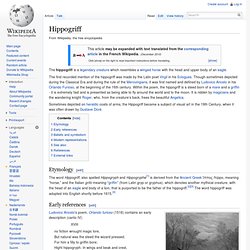

Category:Mythological horses. Kelpie. The kelpie is a supernatural water horse from Celtic folklore that is believed to haunt the rivers and lochs of Scotland and Ireland; the name may be from Scottish Gaelic cailpeach or colpach "heifer, colt".[1] Folklore[edit] In mythology, the kelpie is described as a strong and powerful horse.

It is a white and sky blue colour and appeared as a lost pony, but could be identified by its constantly dripping mane. Its mane and tail are a bit curly. Its skin was said to be like that of a seal, smooth but as cold as death when touched. The fable of the kelpie varies by region. Similar creatures[edit] There are many mythological creatures similar to the kelpie, such as the "nuggle" from Orkney, and a "shoopiltee," or "njogel," or "tangi" from Shetland. In popular culture[edit] See also[edit] References[edit]
Hippogriff. The hippogriff is a legendary creature which resembles a winged horse with the head and upper body of an eagle.

Sometimes depicted on heraldic coats of arms, the Hippogriff became a subject of visual art in the 19th Century, when it was often drawn by Gustave Doré. Etymology[edit] The word Hippogriff, also spelled Hippogryph and Hippogryphe[1] is derived from the Ancient Greek ἵππος /híppo, meaning “horse,” and the Italian grifo meaning “griffin” (from Latin gryp or gryphus), which denotes another mythical creature, with the head of an eagle and body of a lion, that is purported to be the father of the hippogriff.[2][3] The word hippogriff was adopted into English shortly before 1615.[4] Early references[edit] Hippogriff, illustration by Gustave Doré for Orlando furioso. Ludovico Ariosto's poem, Orlando furioso (1516) contains an early description (canto IV): no fiction wrought magic lore, But natural was the steed the wizard pressed; For him a filly to griffin bore; Hight hippogryph.
Saxon Steed. Bronze statue of the Saxon Steed in Hanover, in Germany.

The Saxon Steed (German: Sachsenross, Niedersachsenross, Welfenross, Westfalenpferd; Dutch: Twentse Ros; English: White Horse of Kent: Low Saxon: Witte Peerd) is a favorite heraldic motif of the Saxons. Origin and past uses[edit] The Saxon Steed originated in the tribal Duchy of Saxony. It is said that it originates from the black (heathen) and white (Christian) horse the Saxon leader Widukind rode on, or Odin's horse Sleipnir. There is also a very common roof-sign on (farm)houses with 2 horseheads which can refer to Hengist and Horsa, the quasi-mythical progenitors of the English nation who led the Anglo-Saxon migration to southern Britain in the 5th Century AD.
Modern uses[edit] The white horse is similar to the one used in the coat of arms for the county of Kent in England, which is likely to have originated in the Rhineland area.
Helhest. Folklore[edit] The horse figures into a number of Danish phrases as recent as the 19th century, such as "han går som en helhest" ("he walks like a hel-horse") for a male who "blunders in noisily".

The helhest is sometimes described as going "around the churchyard on his three legs, he fetches Death", and from Schleswig, a phrase is recorded that, in time of plague, "die (corrected by Grimm from der) Hel rides about on a three-legged horse, destroying men".[1] 19th century scholar Benjamin Thorpe connects the Danish phrase "he gave death a pack of oats" when an individual survives a near-fatal disease to notions of the Helhest, considering the oats either an offering or a bribe.[2] According to folklore, the Aarhus Cathedral yard at times features the Hel-horse. A tale recorded in the 19th century details that, looking through his window at the cathedral one evening, a man yelled "What horse is outside? " A man sitting beside him said "It is perhaps the Hel-horse. "